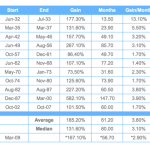Historical Perspective: How Today's U.S. Stock Market Stacks Up …

By David Larrabee, CFA
As the bull market for U.S. stocks approaches its fifth anniversary, we are starting to see signs typically associated with the latter stages of a multi-year advance in equities. Bearish sentiment, widely seen as a contrarian indicator, has dropped to levels not seen in a generation, retail investors are returning to stocks, and the IPO market has been surging. As further evidence, in the name of innovation, Wall Street is once again rolling out risky products that are almost certain to disappoint the unwitting buyer.
For perspective, we thought it would be a good time to compare today’s market to past bull markets. Using Bloomberg pricing data for the S&P 500 Index (SPX), we identified 12 bull markets between 1932 and today. (We define a bull market as one which gains at least 20% off its bear market bottom over a period of 6 months or more.)
US Bull Markets (1932-Present)
(click to enlarge)
A few observations:
Duration – Previous bull markets ranged from 14 months (1932-1933) to 148 months (1987-2000), with an average duration of 60 months. Today’s bull market is in its 57th month, suggesting that this advance has not yet overstayed its welcome but may be in the “late innings.”Gain – Previous bull markets gained between 74% (1970-1973) and 582% (1987-2000), with an average gain of 185% and a median gain of 132%. During the current bull market, the S&P 500 Index has so far gained 167%, as measured to its recent peak. This ranks as the fifth largest gain of the 12 bull markets studied.Velocity – Previous bull markets advanced at different paces, ranging from an average 1.39% monthly gain (1962-1968) to a 13.1% monthly gain (1932-1933). The average monthly gain was 3.8% and the median monthly gain was 3.1%. However, the current bull market’s average monthly gain of 2.9% is on a pace that has been exceeded only twice in the past half century, during the bull markets leading up to 1987 market crash and the dot-com crash of 2000.
History shows each bull market to be different, and stock prices can be heavily influenced by factors like monetary and fiscal policy, and the behavioral idiosyncrasies of investors. Ultimately, however, prices reflect the underlying economic fundamentals of the economy and the financial performance of individual companies. As legendary value investor Ben Graham wrote in The Intelligent Investor:
Price fluctuations have only one significant meaning for the true investor. They provide him with an opportunity to buy wisely when prices fall sharply and to sell wisely when they advance a great deal. At other times he will do better if he forgets about the stock market and pays attention to . . . the operating results of his companies.
Long-term investors would do well to heed Graham’s advice.
Disclaimer: Please note that the content of this site should not be construed as investment advice, nor do the opinions expressed necessarily reflect the views of CFA Institute.
Source:
Historical Perspective: How Today’s U.S. Stock Market Stacks Up Against Past Bull Markets
This article was sent to
people who get email alerts on
.
Get email alerts on »
This article was sent to
338,701
people who get the Macro View newsletter.
Get the Macro View newsletter »
The #1 Portfolio App is Now on iPad!
Get instant notifications & never miss a critical update on your stocks!
Which Seeking Alpha App is best for you?Seeking Alpha PortfolioTech InvestorETF investorEnergy InvestorEmail me a link to open from my phone:ContinueGet the app »Get the app »
PORTFOLIO
SymbolAlertsPriceChg% ChgAdd Stocks
people received this article by email alert
Add your email to get alerts on too:
Get email alerts on »
This article was sent to
338,701
people who get the Macro View newsletter.
Get the Macro View newsletter »Tagged: Macro View
,
Share this article with a colleague
BOOKMARKED / READ LATER
View original article:
Historical Perspective: How Today's U.S. Stock Market Stacks Up …
See which stocks are being affected by Social Media

